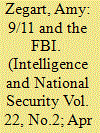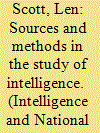| Srl | Item |
| 1 |
ID:
079217


|
|
|
|
|
| Publication |
2007.
|
| Summary/Abstract |
Public discussion about the 11 September 2001 terrorist attacks has focused on the human causes of tragedy - on individual mistakes, failures of leadership, and the power plays between intelligence officers in the field and policymakers in Washington. But closer examination of the FBI suggests that organizational weaknesses are the root cause of poor agency performance. Longstanding deficiencies in the FBI's organizational structure, culture, and incentive systems proved crippling in the 1990s, when the Cold War ended and the terrorist threat emerged. These lingering weaknesses ultimately prevented the bureau from capitalizing on 12 separate opportunities that might have disrupted the 9/11 plot
|
|
|
|
|
|
|
|
|
|
|
|
|
|
|
|
| 2 |
ID:
079219


|
|
|
|
|
| Publication |
2007.
|
| Summary/Abstract |
The War Office's First World War cryptanalytic bureau MI1(b) has been severely overshadowed by its more glamorous equivalent in the Admiralty, 'Room 40'. In particular its diplomatic decryption work has gone completely unnoticed; yet this was its main activity, and it contributed more than did Room 40 to their common successor, the Government Code and Cypher School (GC&CS). This article, drawing on the past decade's releases of GC&CS archives, traces the development of MI1(b)'s diplomatic work, disentangles its achievements from those of its better-known naval colleague, describes how the two organizations were merged to become GC&CS, and suggests why MI1(b)'s achievements were so quickly forgotten
|
|
|
|
|
|
|
|
|
|
|
|
|
|
|
|
| 3 |
ID:
079220


|
|
|
|
|
| Publication |
2007.
|
| Summary/Abstract |
The origins of the Anglo-American intelligence relationship are usually dated to the early years of the Second World War. This article suggests that the First World War interaction between the intelligence staffs of the British and American Expeditionary Forces was a significant precursor to the emergence of the later relationship. Using primarily American archival sources, the article reveals an intimacy that emerged in the summer of 1917 and continued, to a lesser extent, until the armistice. The emergence of this close relationship is attributed to a common language, independent-minded intelligence leaders, and an element of chance
|
|
|
|
|
|
|
|
|
|
|
|
|
|
|
|
| 4 |
ID:
079218


|
|
|
|
|
| Publication |
2007.
|
| Summary/Abstract |
Since September 2001, jihadist attacks on the West and the war on Iraq have focused public attention on intelligence and invigorated academic interest in intelligence studies. Once neglected in academia, the subject is now increasingly firmly established in British and American universities. Common interest in understanding the value as well as the limitations of intelligence nevertheless disguises differing epistemological foundations. Until the late 1980s official British attitudes to secrecy, including opposition to any form of public accountability, inhibited and distorted public understanding. The last two decades have seen changing attitudes to both archival disclosure and parliamentary accountability, though the significance of these is contested. This article outlines these changes as well as how various authors have used various sources to represent the secret world. Two specific areas are explored: covert action and the joint intelligence machinery. The former presents particularly interesting challenges to academic and public scrutiny (in some contrast to the United States) while the latter has received unprecedented illumination in the wake of the failure to discover weapons of mass destruction in Iraq. While opportunities for understanding British intelligence remained constrained they are nevertheless more propitious than they have ever been
|
|
|
|
|
|
|
|
|
|
|
|
|
|
|
|